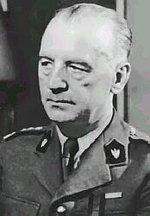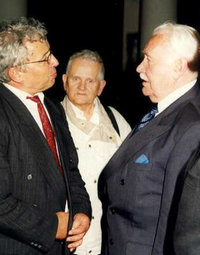Polish government in exile
|
|
Template:Polish statehood The Government of the Polish Republic in exile was the government of Poland after the German occupation of Poland in September 1939. It commanded Polish forces during the war. Though largely unrecognised and without effective power after the end of the war, it remained in existence until the end of Communist rule in Poland in 1990 when it formally handed over its responsibility to the new government.
| Contents |
History
Establishment
On September 17, 1939, the President of the Polish Republic, Ignacy Moscicki, who was then in the small town of Kosow near the southern Polish border, signed an act appointing Wladyslaw Raczkiewicz, the Speaker of the Senate, as his successor. This was done in accordance with Article 24 of the Constitution of the Republic of Poland, which provided as follows:
"In the event of war the term of the President's office shall be prolonged until three months after the conclusion of peace; the President of the Republic shall then, by a special act, promulgated in the Official Gazette, appoint his successor, in case the office falls vacant before the conclusion of peace. Should the President's successor assume office, the term of his office shall expire at the end of three months after the conclusion of peace." Template:Polish Secret State Raczkiewicz, who was already in Paris, immediately took his constitutional oath at the Polish Embassy there and became President of the Republic of Poland. He then appointed General Wladyslaw Sikorski as Commander-in-Chief of the Polish Armed Forces and Prime Minister.
Most of the Polish Navy escaped to Britain, and thousands of other Poles escaped through Romania or across the Baltic Sea to continue the fight. Many Poles took part in defence of France, in the Battle of Britain, at Cassino, Arnhem and other operations beside British forces.
Wartime history
Main article: History of Poland (1939-1945)
The government in exile, based first in Paris and then in London, was recognised by all the Allied governments. Politically, the government was a coalition of the Polish Peasant Party, the Polish Socialist Party and the National Democratic Party, although these parties maintained only a vestigial existence in the circumstances of exile.
When Germany attacked the Soviet Union in 1941, the Polish government in exile established diplomatic relations with the Soviet Union, despite Stalin's role in the destruction of Poland. Hundreds of thousands of Polish soldiers who had been taken prisoner by the Soviet Union in eastern Poland in 1939, and many other Polish prisoners and deportees, were released and were allowed to leave the country via Iran. They formed the basis for the 2nd Polish Corps led by General Wladyslaw Anders, which together with other earlier created Polish units fought alongside the Allies.
In April 1943 the Germans announced that they had discovered the graves of 4,300 Polish officers who had been taken prisoner in 1939 and murdered by the Soviets, in a mass grave in Katyn Wood near Smolensk. The Germans invited the International Red Cross to visit the site, and they confirmed both that the graves contained Polish officers and that they had been killed with Soviet weapons. The Soviet government said that the Germans had fabricated the discovery. The Allied governments, for diplomatic reasons, formally accepted this, but the Polish government in exile refused to do so.
Stalin then severed relations with the government in exile. Since it was clear that it would be the Soviet Union, not the western Allies, who would liberate Poland from the Germans, this breach had fateful consequences for Poland. In an unfortunate coincidence, Sikorski, the most talented of the Polish exile leaders, was killed in an aircrash near Gibraltar in July. He was succeeded as head of the government in exile by Stanislaw Mikolajczyk.
During 1943 and 1944 the Allied leaders, particularly Winston Churchill, tried to bring about a resumption of talks between Stalin and the government in exile. But these efforts broke down over several issues. One was the massacre at Katyn. Another was Poland's postwar borders. Stalin insisted that the territories annexed in 1939, which had a majority of Ukrainians and Byelorussians, should remain in Soviet hands, and that Poland should be compensated with lands to be annexed from Germany. Mikolajczyk refused to compromise on this issue. A third issue was Mikolajczyk's insistence that Stalin not set up a Communist government in postwar Poland.
Postwar history
Main article: History of Poland (1945-1989)
In November 1944, despite his mistrust of the Soviets, Mikolajczyk resigned to return to Poland and take office in the new government established under the auspices of the Soviet occupation authorities. Many of the Polish exiles opposed this action, believing that this government was a fašade for the establishment of Communist rule in Poland, a view that was later proved correct; after losing an election which was later shown to have been fraudulent, Mikolajczyk left Poland again in 1947.
Meanwhile the government in exile had maintained its existence, but the United States and the United Kingdom withdrew their recognition on July 6, 1945. The Polish armed forces in exile were disbanded in 1945 and most of their members, unable to return to Communist Poland, settled in other countries. The London Poles had to leave the embassy on Portland Place and were left only with the president's private residence at 43 Eaton Place. The government in exile then became largely symbolic, serving mainly to symbolise the continued resistance to foreign occupation of Poland, and retaining control of some important archives from pre-war Poland. Ireland and Spain were the last countries to recognize the government in exile.
In 1954 political differences led to a split in the ranks of the government in exile. One group, claiming to represent 80% of 500,000 anti-Communist Poles exiled since the war, was opposed to President August Zaleski's continuation in office when his seven-year term expired. It formed a Council of National Unity on July 31, 1954, and set up a Council of Three to exercise the functions of head of state, consisting of Tomasz Arciszewski, General Wladyslaw Anders, and Edward Raczynski. Only after Zaleski's death in 1972 did the two factions reunite.
Some supporters of the government in exile eventually returned to Poland, such as Prime Minister Hugon Hanke in 1955 and his predecessor Stanislaw Mackiewicz in 1956. The Warsaw government actively campaigned for the return of the exiles, promising decent and dignified employment and forgiveness of past transgressions.
Despite these setbacks, the government in exile maintained its existence. At the time Communist rule came to an end in Poland in 1989, there was still a president and a cabinet of eight meeting every two weeks in London, commanding the loyalty of many of about 150,000 Polish veterans and their descendants living in Britain, including 35,000 in London alone.
In December 1990, when Lech Walesa became the first post-Communist President of Poland, he received the symbols of the Polish Republic (the red presidential banner, the presidential and state seals, the presidential sashes, and the original text of the 1935 constitution) from the last President of the government in exile, Ryszard Kaczorowski, thus re-establishing the continuity of the Republic and in effect retrospectively recognising the legitimacy of the government in exile. In 1992 military medals and other decorations awarded by the government in exile were officially recognised in Poland.
Government and politics
Presidents
- Wladyslaw Raczkiewicz: 30 September 1939 to 6 June 1947
- August Zaleski: 9 June 1947 to 7 April 1972
- Stanislaw Ostrowski: 9 April 1972 to 24 March 1979
- Eduard Raczynski: 8 April 1979 to 8 April 1986
- Kazimierz Sabbat: 8 April 1986 to 19 July 1989
- Ryszard Kaczorowski: 19 July 1989 to 22 December 1990
Prime ministers
- Wladyslaw Sikorski: 30 September 1939 to 4 July 1943
- Stanislaw Mikolajczyk: 5 July 1943 to 29 November 1944
- Tomasz Arciszewski: 29 November 1944 to 2 July 1947
- Tadeusz Bˇr-Komorowski: 2 July 1947 to 7 April 1949
- Tadeusz Tomaszewski: 7 April 1949 to 25 September 1950
- Roman Odzierzynski: 25 September 1950 to 18 January 1954
- Jerzy Hryniewski: 18 January 1954 to 8 June 1954
- Stanislaw Mackiewicz: 8 June 1954 to 8 August 1955
- Hugon Hanke: 8 August 1955 to 11 September 1955
- Antoni Pajak: 11 September 1955 to 25 June 1965
- Aleksander Zawisza: 25 June 1965 to 16 July 1970
- Zygmunt Muchniewski: 16 July 1970 to August 1972
- Alfred Urbanski: August 1972 to 1976
- Kazimierz Sabbat: 1976 to 7 April 1986
- Edward Szczepanik: 7 April 1986 to 22 December 1990
Armed forces
Main article: Polish contribution to World War II
Culture, economy, geography, demographics
See also
External links
- Statement of the Polish government in exile following the death of General Sikorski (1943) (http://www.republika.pl/unpack/1/dok01a.html)
- Publications on the Polish Government (In Exile) 1939-1990 (http://www.angelfire.com/realm/StStanislas/Publications.html)
- Stamp Issues by the Polish Government in Exile (http://www.sossi.org/exile/poland.htm)
- Polish forces in the west during World War II (http://home.golden.net/~medals/exile.html)


